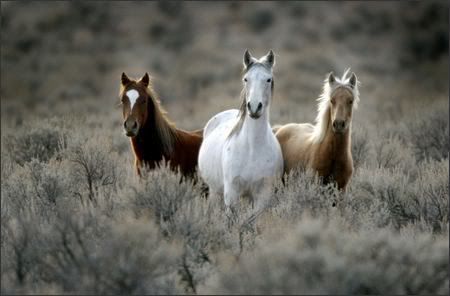
Preview
Material for Exam 3 - Fall 2009
Print
the PDF version (no pictures, better printing)
We return, again, to the never ending saga of Big Foot. After being harassed by searchers after the initial Big Foot finding, a small Big Foot group in Georgia finds an isolated mountain valley where they can live. The valley is approximately 10,000 acres, has plentiful food and water sources as well as tree cover. The founder population is made up of 6 individuals. There are 2 births and no deaths each of the first 3 years in the valley. After the third year in the valley, the growth rate (r) changes to 0.17 for the fourth year. Although the total Big Foot population in the North Georgia mountains has a wide variety of fur colors (everything from golden-brown to black), the Big Foot in the isolated valley all have black fur. The section of DNA which normally codes for black fur reads GCAGTAGGAGCT. After the mutation, the same segment of DNA, which now encodes for the brown fur, reads GCAGTTGGAGCT. (Don't panic - you will have a chart )
 source
source source
source source
sourceThe Eastern Fox Squirrel with grey fur has somehow managed to arrive in Davis, California. They never existed there before. The city wants to know if the population of squirrels is going to grow to a large size and how quickly. You spend a year tagging some of the squirrels and observing how many babies they have. The size of the squirrel population at the beginning of Year 1 is 50. You observe that their birth rate (b) is 1.1 babies per year per squirrel and the death rate (d) is 0.3 deaths per year per squirrel.
During Year 5 you notice some of squirrels have brown fur. After doing some breeding experiments you discover that squirrel fur color is determined by a single gene with two alleles. FF and Ff individuals are grey and ff individuals are brown. A male Eastern Fox Squirrel has 20 chromosomes in his sperm cells.

source
A Mustang is a free-roaming, feral horse of Western North American, which descended from horses brought to the Americas by the Spanish. The Mustang is known for its traits of hardiness and durability, and has adapted to survive different habitats that range from perennial grasslands to desert scrublands. Native Americans found the Mustang to be useful for transportation. Today, Mustangs are found on allocated land, Indian Reservations, and Public Lands. The Mustang is able to respond to predators quickly, thereby avoiding being captured and eaten. A Mustang’s hoof is known for its hardness which makes it very durable. The durability of the hoof helped the Mustang to survive. The Mustang is resistant to many types of bacterial infections.
The Mustang population is recorded over a 10-year period and the data are presented in graph form (number of Mustangs vs year). An earthquake killed many Mustangs during the study period. In 1999, the Southwest had one of the driest years recorded in history. In year one, 50 Mustangs were born and 40 died (starting population = 100).
Joe the Plumber purchased a Mustang. Joe soon discovered that he was not a horseman and ended up in the hospital needing a blood transfusion to save his life. The medical staff gave Joe Type O blood. Joe realized that the medical staff saved his life. While in the hospital, he learned more about blood transfusions and blood typing
 source
source source
sourceHorn flies are a species of biting flies that feeds on the blood of cattle. To control the flies and protect cattle, an insecticide called diazinon, which inhibits acetylcholinesterase, is often used. Recently, scientists were asked to investigate a population of horn flies that have become resistant to diazinon. The scientists brought a few flies back to the laboratory and put them in a large room that had more than enough resources to support many generations of growth and no predators or disease were present. 100 flies were originally introduced to the laboratory and the scientist maintaining the flies reported a birth rate of 1 flies/fly/day and a death rate of 0.1 flies/fly/day for the first day.
The scientists found that the diazinon-resistant flies had a mutation in the gene that codes for acetycholinesterase (a protein). Following the mutation, acetycholinesterase still works, but is no longer disabled by diazinon. The mutation results in a shift from glycine to alanine. The scientists also found that the trait for resistance is autosomal dominant. The scientists also have horn flies in their laboratory from a population that is susceptible (meaning diazinon easily kills the flies). In yet another experiment, the scientists allowed a diazinon-resistant fly and a susceptible fly to breed. The scientist then tested 15 of the offspring and found that 7 were resistant and 8 were susceptible.

source
One form of Charcot-Marie-Tooth Disease (CMTX) is caused by a change in a nucleotide in the connexin-32 gene on the X chromosome. The connexin-32 protein forms part of the myelin sheath that surrounds nerve cells. Males who inherit a mutant allele from their mothers show moderate to severe symptoms of the disease beginning in late childhood or adolescence. Females who possess one mutant allele and one normal allele also develop symptoms. The disease affects peripheral nerves and typically results in weakness of the foot and lower leg muscles accompanied by frequent tripping.
You are acting as a health care provider in a remote location and only have one unit (container) of blood left. You can only use it to transfuse blood to one of the sick children in your field hospital (don’t worry, more is on the way). Unfortunately, the label has worn off the unit so you don’t know the type of blood in it. You also don’t know any of the children’s blood types, but the children’s parents are all there and can tell you their own blood types.

source
 source
source source
source